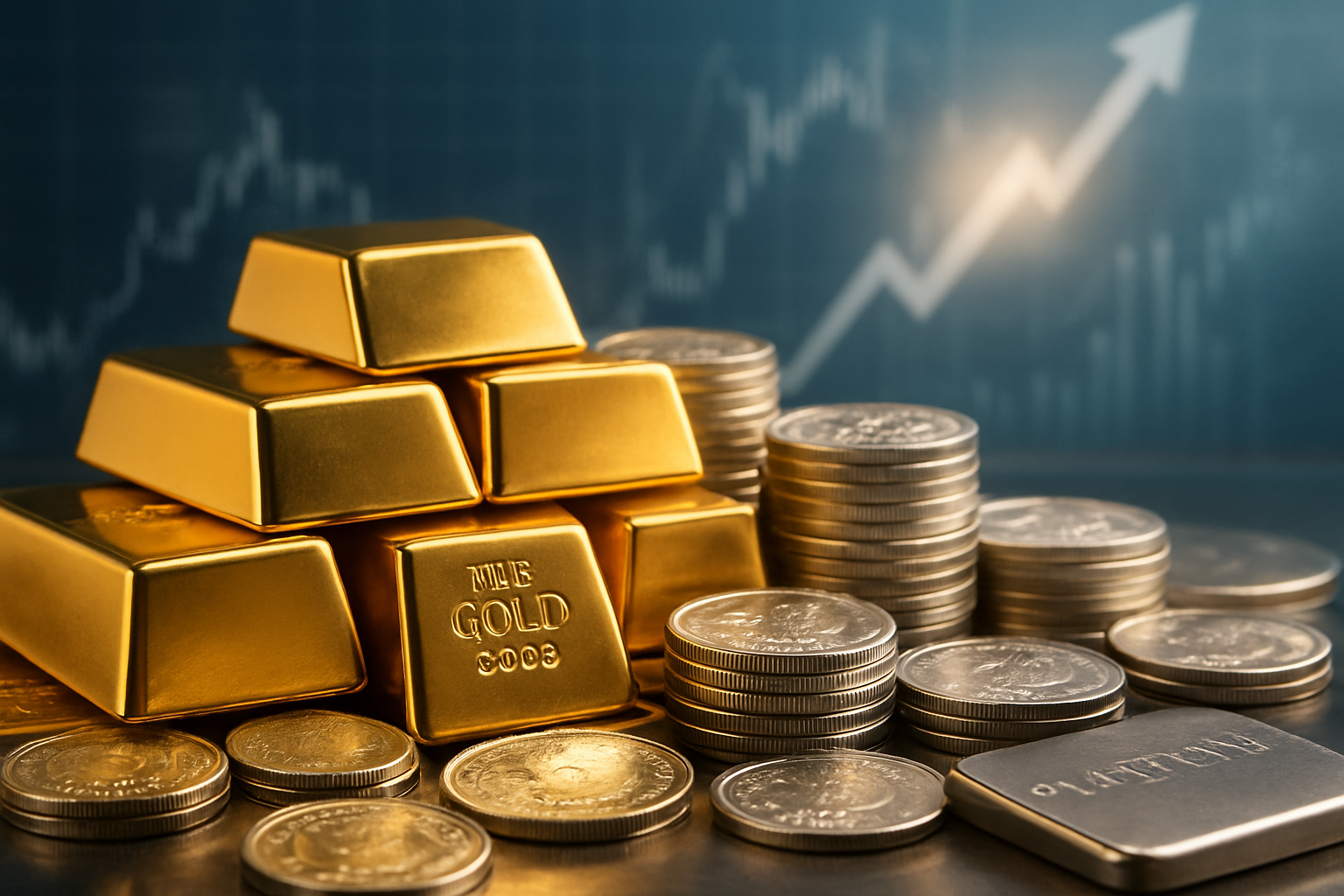
November 6, 2025 - The global financial landscape is witnessing a remarkable resurgence in the precious metals market, marking a pivotal moment for investors seeking stability and growth amidst an increasingly volatile world. Driven by a potent combination of persistent inflation, shifting central bank policies, and heightened geopolitical tensions, gold, silver, and platinum are not just holding their ground but are actively building significant momentum, attracting renewed interest from both institutional and retail investors. This surge signals a new era for precious metals, solidifying their role as essential safe-haven assets and powerful hedges against economic instability.
The burgeoning strength in the precious metals sector is not merely a fleeting trend but a reflection of deeper systemic shifts. As traditional investment avenues grapple with uncertainty, the tangible value and historical reliability of precious metals are proving irresistible. This renewed confidence is translating into expanding investment opportunities, pushing market participants to explore diverse avenues within the sector, from physical bullion to exchange-traded funds and mining equities, as they strategically position themselves for sustained demand and portfolio diversification.
Precious Metals Market Builds Momentum
The current bullish sentiment pervading the precious metals market in November 2025 is a culmination of several intertwined global factors, painting a clear picture of robust and sustained growth. Gold, silver, and platinum have demonstrated exceptional performance throughout 2025, reaching multi-year highs and, in some cases, all-time records. This upward trajectory is fueled by an intricate dance of macroeconomic forces, geopolitical uncertainties, and supply-side constraints.
The timeline leading up to this moment has been characterized by escalating inflationary pressures that began intensifying in late 2024 and persisted well into 2025, prompting central banks globally to reassess their monetary policies. Expectations of interest rate cuts by major central banks throughout 2025 have significantly reduced the opportunity cost of holding non-yielding assets like precious metals, making them more attractive. Concurrently, a weakening U.S. dollar has further bolstered demand from international buyers, as dollar-denominated commodities become more affordable. Geopolitical instability, particularly ongoing conflicts in Eastern Europe and the Middle East, along with broader global trade tensions, have consistently reinforced the safe-haven appeal of these metals. Central banks, notably those in emerging economies, have been key players, consistently increasing their gold reserves as part of strategic diversification efforts, with purchases projected to be around 900 tonnes in 2025 alone.
Initial market reactions have been overwhelmingly positive, with significant inflows into precious metal-backed exchange-traded funds (ETFs) and a noticeable uptick in demand for physical bullion. Gold (XAU) has been a standout performer, surging over 25% by April and breaching the $2,900/ounce mark in February, eventually peaking near $4,400/ounce in October before settling around $4,000/ounce. Silver (XAG) has outpaced gold in percentage terms, starting the year around $28.92/ounce and surging past $48/ounce by November, marking a 14.5-year high. Platinum (XPT) has also seen an extraordinary comeback, with prices jumping 28% in June and touching an 11-year high of $1,432.60/ounce, now trading around $1,553.50/t.oz. Even Palladium (XPD), despite long-term challenges from the shift to electric vehicles, has shown upward momentum in the first half of 2025, reaching $1,288/ounce in July and currently trading around $1,444/t.oz. The sustained demand, coupled with persistent supply deficits due to mining difficulties and labor shortages, has created a fertile ground for price appreciation across the board.
Expanding Investment Opportunities
The burgeoning precious metals market is not just about rising prices; it's also about a diversification of investment opportunities that cater to a wide range of investor profiles and strategic objectives. This dynamic environment is creating clear winners and losers across the investment landscape, with particular implications for mining companies, industrial users, and financial institutions.
Mining companies are poised to be significant beneficiaries of this upward trend. Companies with strong production profiles, efficient operations, and substantial reserves in gold, silver, and platinum are seeing increased revenue and profit margins. For instance, major gold miners like Barrick Gold Corp. (NYSE: GOLD) and Newmont Corporation (NYSE: NEM) are likely to experience enhanced profitability and stock appreciation as gold prices remain elevated. Similarly, silver producers such as Pan American Silver Corp. (NASDAQ: PAAS) and Wheaton Precious Metals Corp. (NYSE: WPM) stand to gain substantially from silver's impressive performance and its critical role in green technologies. Platinum group metals (PGM) miners, particularly those with significant platinum exposure like Anglo American Platinum Limited (JSE: AMS) and Impala Platinum Holdings Limited (JSE: IMP), are benefiting from platinum's robust comeback and projected supply deficits. These companies could see their stock valuations climb, offering attractive returns to investors.
Conversely, companies heavily reliant on palladium for industrial applications, especially in traditional automotive catalytic converters, might face long-term headwinds despite palladium's recent short-term gains. The accelerating global shift towards electric vehicles could diminish future demand for palladium, potentially impacting the profitability of companies that have not diversified their PGM usage or invested in alternative technologies. Furthermore, financial institutions that are underweight in precious metals or have significant exposure to assets negatively impacted by inflation and geopolitical instability might find themselves at a disadvantage, as investors reallocate capital towards safe-haven assets. The increased cost of raw materials for manufacturers that use precious metals in their products, without the ability to pass on these costs, could also squeeze profit margins.
New investment avenues are also emerging. Beyond direct ownership of physical bullion, which remains a cornerstone for wealth preservation, investors are increasingly turning to precious metals ETFs for liquidity and ease of access. These funds, such as SPDR Gold Shares (NYSEARCA: GLD) and iShares Silver Trust (NYSEARCA: SLV), have seen substantial inflows, reflecting growing institutional confidence. Furthermore, the critical role of silver and platinum in booming green technologies, including solar panels, electric vehicles, and hydrogen fuel cells, presents unique opportunities. Companies involved in the supply chain for these technologies, even if not direct miners, could indirectly benefit from the sustained demand for these industrial precious metals. Diversified portfolios that include a mix of physical metals, mining stocks, and ETFs are becoming a favored strategy for investors looking to balance risk and capitalize on the sector's broad-based momentum.
Sustained Demand for Gold and Diversification Across the Investment Landscape
The current surge in the precious metals market is not an isolated event but rather a significant development that fits into broader industry trends, particularly the increasing global demand for safe-haven assets and a strategic shift towards portfolio diversification. This event underscores a fundamental recalibration of investment strategies in response to an evolving global economic and geopolitical order.
One of the most profound broader industry trends is the persistent and growing demand for gold, which remains the quintessential safe-haven asset. This demand is being driven by multiple factors, including sustained inflationary pressures globally, which erode the purchasing power of fiat currencies, making gold an attractive store of value. Furthermore, the ongoing de-dollarization efforts by various central banks, particularly in emerging markets, have led to substantial gold accumulation, signaling a long-term strategic shift away from reliance on a single reserve currency. This central bank activity provides a robust floor for gold prices and indicates a structural rather than cyclical demand. The event also highlights a broader trend of investors seeking tangible assets that are less correlated with traditional equity and bond markets, thereby enhancing portfolio resilience during periods of heightened volatility.
The ripple effects of this momentum are widespread. Competitors in the investment landscape, particularly those offering traditional financial products that are more susceptible to inflation or market downturns, may experience a reallocation of capital towards precious metals. This could prompt financial advisors and asset managers to increase their exposure to commodities and alternative assets, including precious metals, to meet client demand for diversification and risk mitigation. Partners in the mining and refining sectors will likely see increased business, while technology companies reliant on specific precious metals like silver for electronics or platinum for hydrogen fuel cells will need to secure stable supply chains, potentially leading to long-term contracts and strategic alliances.
Regulatory or policy implications could also emerge. Governments might consider policies related to domestic mining incentives to secure critical mineral supplies, especially for industrial precious metals vital for green technologies. There could also be increased scrutiny on the transparency and traceability of precious metals, driven by environmental, social, and governance (ESG) considerations, potentially leading to new industry standards. Historically, periods of high inflation and geopolitical uncertainty have consistently seen a flight to precious metals. Comparisons to the 1970s, when gold prices soared amidst oil crises and high inflation, or the post-2008 financial crisis era, when gold and silver saw significant gains, provide historical precedents for the current market dynamics. These historical parallels reinforce the enduring role of precious metals as crucial components of a diversified investment strategy during turbulent times.
What Comes Next
Looking ahead, the trajectory of the precious metals market appears poised for continued dynamism, presenting both opportunities and challenges for investors and industry players alike. The short-term outlook suggests sustained upward pressure, particularly for gold, silver, and platinum, while the long-term prospects hinge on the evolution of global economic policies, geopolitical stability, and technological advancements.
In the short term, the market is likely to remain highly sensitive to central bank announcements regarding interest rates, particularly from the U.S. Federal Reserve, European Central Bank, and Bank of England. Any indications of delayed rate cuts or unexpected hawkish shifts could introduce temporary volatility, but the underlying drivers of inflation and geopolitical risk are expected to keep a floor under precious metal prices. Continued central bank buying of gold is also anticipated to provide consistent demand. For silver and platinum, industrial demand, especially from the burgeoning green technology sector (solar, EVs, hydrogen fuel cells), will be a critical short-term catalyst, potentially pushing prices higher due to persistent supply deficits.
Long-term possibilities include gold potentially reaching or even surpassing the $5,000/ounce mark by 2026, as forecasted by some analysts, if inflation remains elevated and global uncertainties persist. Silver could see new all-time highs above $52.50/ounce, driven by its dual role as an investment metal and an industrial commodity. Platinum, with its strong performance and forecast undersupply, is positioned for a sustained recovery and could reclaim its historical premium over gold in certain applications. However, palladium faces a more challenging long-term outlook due to the automotive industry's pivot to electric vehicles, which could lead to a structural surplus in the coming years.
Strategic pivots or adaptations will be crucial for mining companies. Diversifying their portfolios to include a broader range of precious and critical minerals, investing in sustainable mining practices, and exploring new extraction technologies will be essential for long-term viability. For investors, adapting means considering a more diversified precious metals exposure, potentially including platinum as a contrarian play, alongside gold and silver. Market opportunities will emerge in specialized ETFs focusing on green technology metals, as well as in junior mining companies with promising exploration projects. Challenges could include increased regulatory scrutiny, potential supply chain disruptions, and the inherent volatility associated with commodity markets. Potential scenarios range from a continued bullish run, driven by persistent inflation and geopolitical instability, to periods of consolidation if economic conditions stabilize or central banks adopt more aggressive anti-inflationary measures.
Comprehensive Wrap-up
The current momentum in the precious metals market signals a significant shift in investor sentiment and a strategic re-evaluation of asset allocation in a complex global environment. The key takeaways from this period of robust growth are clear: precious metals, particularly gold, silver, and platinum, are reasserting their traditional roles as essential safe havens and hedges against inflation and geopolitical risk. Their impressive performance in 2025 underscores their enduring value and relevance in modern investment portfolios.
Moving forward, the market is expected to remain dynamic, with sustained demand driven by a confluence of macroeconomic factors, including persistent inflationary pressures, a weakening U.S. dollar, and the strategic diversification efforts of central banks. The increasing industrial demand for silver and platinum, fueled by the global transition to green technologies, adds another layer of fundamental support to their price trajectories. While gold continues to be the anchor of the precious metals complex, silver's dual role and platinum's remarkable comeback present compelling opportunities for diversification.
The lasting impact of this period will likely be a more prominent role for precious metals in mainstream investment strategies. Investors are increasingly recognizing the importance of tangible assets that offer protection during times of uncertainty and provide a counterbalance to traditional financial instruments. This heightened awareness and allocation could lead to a more stable and resilient precious metals market in the long run.
For investors, the coming months will require careful monitoring of central bank policies, global inflation data, and geopolitical developments. Watching for continued central bank gold purchases, trends in industrial demand for silver and platinum, and any regulatory changes impacting the mining sector will be crucial. Furthermore, evaluating the performance of mining companies and precious metals ETFs will provide insights into market sentiment and potential investment opportunities. The current environment strongly suggests that a well-diversified portfolio that includes a thoughtful allocation to precious metals is not just prudent but increasingly essential for navigating the evolving financial landscape.
This content is intended for informational purposes only and is not financial advice






